Varieties
Tuff is a rather abstract concept, referring to a group of sedimentary rocks, which sometimes do not even look similar. In view of this, when purchasing a material, you should always clarify what kind of raw materials are in question, including the size of the blocks, since the mineral is sold even in the form of a powder for the manufacture of cement based on it.
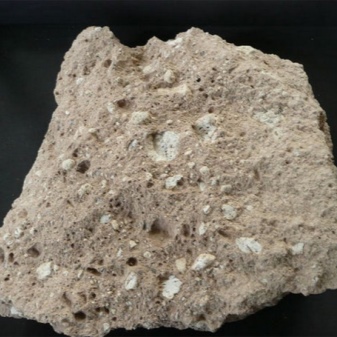

Let's briefly go over some of the classification criteria for tuffs.
By field
Tuff is a rock, it is formed only where volcanoes previously acted, hot springs beat, geysers functioned. At the same time, the chemical composition of lava or water in the springs could be quite different, and even the method of formation of the mineral was different, so it should not be surprising that completely different types of material are obtained from different deposits.

The tuff that is most recognizable among the inhabitants of the post-Soviet space is best called Armenian - there it is abundantly mined in the Artik region. This material stands out especially well against the background of all the others due to the fact that it has a pink or even slightly purple color, sometimes deviating towards dark brown and black. But one must understand that these are not typical tuff tones, but just unique ones. If you have ever seen a typical Armenian temple, then in the future you will be able to easily identify this stone by eye.

The Caucasus is, in principle, rich in tuff deposits, they are found everywhere here. Georgian tuff is probably the rarest in the world because it has a pleasant golden color. Kabardian tuff, which is already mined on the territory of Russia, is closer to the Armenian one, has pinkish tints, but it is relatively few and not so beautiful. The spurs of the Caucasian deposits also make it possible to speak of Dagestan and Crimean tuff, and abroad, of the recognizable Iranian yellow tuff.

By composition and structure
Despite the common name, tuff is fundamentally different depending on its origin, and even the chemical composition of such a mineral can change. Natural zeolite mineral comes in the following types of origin.
Volcanic. It is formed in the vicinity of extinct volcanoes, since it is volcanic ash, which, after the eruption, settled and compressed. At least half (and sometimes up to three quarters) of the composition of such a mineral is silicon oxide, another 10-23% is aluminum oxide. Depending on the exact composition, volcanic tuffs are subdivided into even smaller varieties, such as basaltic, andesite, and so on.
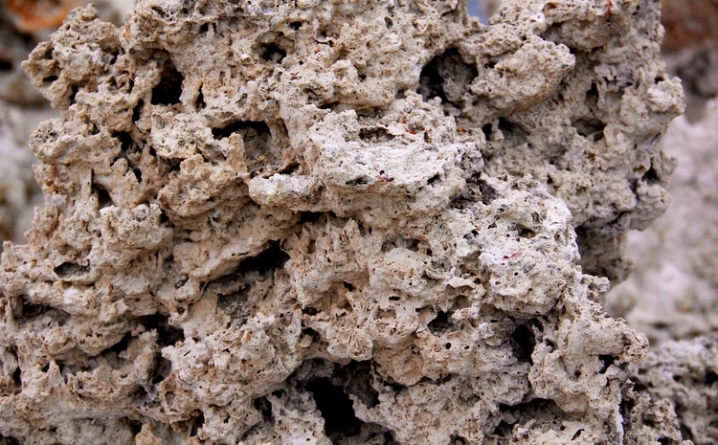
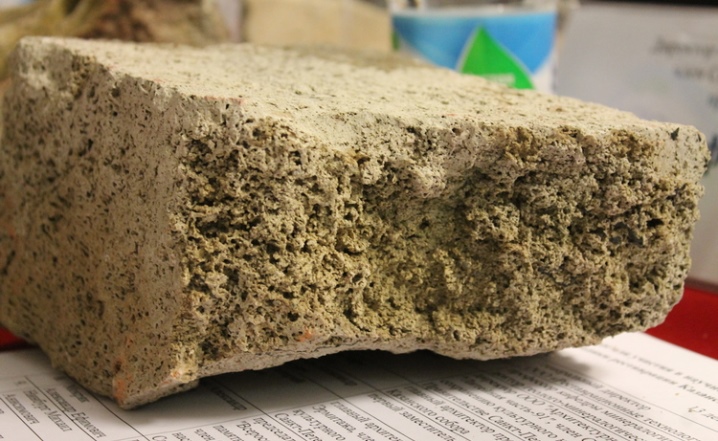
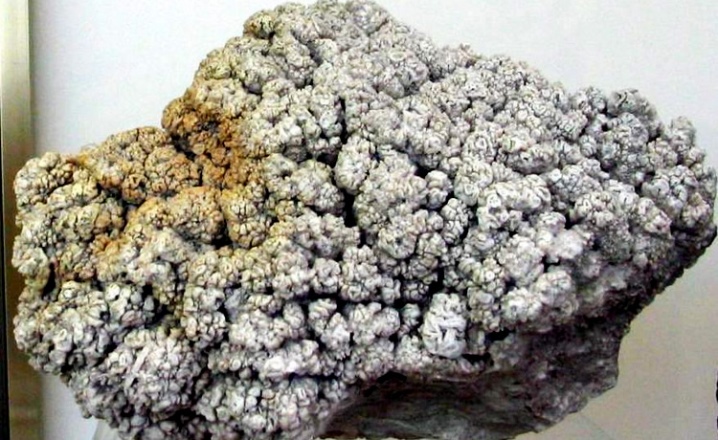
By color
As mentioned above, for citizens of post-Soviet countries, tuff in general is most associated with its Armenian variety, which is distinguished by pleasant brown, pink and purple hues.
However, given how diverse the chemical composition of this mineral can be, it shouldn't come as a surprise that its color palette is almost unlimited. Roughly speaking, you can choose any color and hope that tuff of this color exists in nature. Another thing is that the nearest required deposit can be quite far away. And this will negatively affect the cost, but in general, even the most rare golden mineral is mined, even if not in Russia, but nearby - in Georgia.
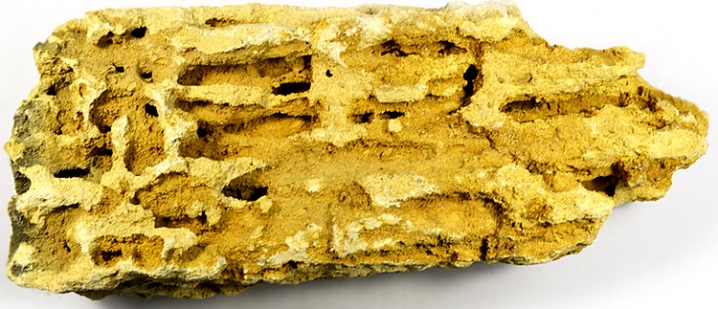
Otherwise, you can count on the acquisition of the most popular shades of stone, which are predictably white and black.
In addition, you can stand out by using red varieties of the mineral, although then it already makes sense to pay attention to the Armenian pink "classics"
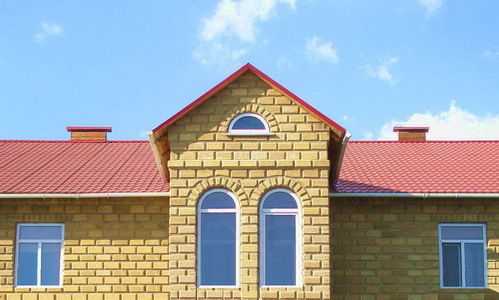
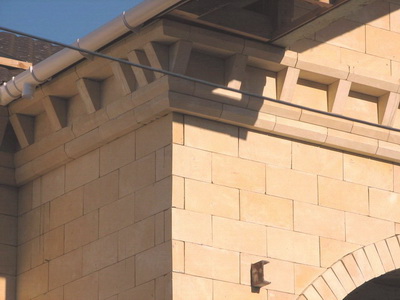
SANDSTONE
Sedimentary rock; homogeneous or layered aggregation of grains of sand bound by any mineral substance (cement). The strength of the material depends on this element: the most durable are siliceous sandstones, if the binder is easily soluble (gypsum or clay), the sandstone is short-lived.
In construction and decoration, quartz sandstones are used, as well as arkoses (with a predominance of feldspars) and graywackes (sandstones of a complex composition with a large percentage of rock fragments).
Color palette: gray, gray-green, shades of yellow, red-brown, brown. Fine-grained red, brown and green sandstone varieties are considered decorative.
Physical properties: density (2250-2670 kg / m3), durability, high wear resistance; water absorption 0.63–6.0%; porosity depends on the composition of the stone and ranges from 0.69 to 6.70%.
Sandstones do not lend themselves to polishing, therefore the most popular textures of sandstone are chipped, sawn, and sometimes polished. According to the degree of processing, sandstones are divided into three groups:
- sawn sandstone (noodles) - solid rock sawn into layers;
- torn sandstone (slab) - natural layers of irregular shape, differing in different sizes and thicknesses;
- rubble sandstone - rough stones obtained by blasting; used for landscaping, laying the foundations of buildings.
Sandstone Application:
- cladding of plinths and walls of houses, fences, columns
- cladding of interiors (in particular, fireplaces) and stairs
- laying footpaths, garden paths, terraces
- landscape design (fountains, streams, cascades, rock gardens)
Leading
Lidite is a black, dense, opaque siliceous (mainly chalcedony) rock with a small admixture of clay material and finely dispersed carbonaceous matter and bitumen.
Lidite has a conchoidal fracture. Organic remains are represented exclusively by radiolarians. Lydite is often identified with phtanites. Like phtanites, lidite is composed of 92–93% silica and is colored black with carbonaceous particles or organic matter (bitumen), in contrast to jasper, which are predominantly pigmented with Fe and Mn oxides. It has been suggested (Fabre, 1959) that some varieties of the lidite rock are freshwater analogs of phtanites (typically marine formations). Silicite lidite is characterized by a mixed structure, which is a combination of relict organogenic, cryptocrystalline and microgranular structures. It is used as the best test stone and whetstones.
Flint
The cherts are dense, more or less homogeneous, concretionary formations, composed, as shown by Weaver's latest research, mainly by very small crystals of quartz and opal, and occurring in the form of nodules or lenticular layers, usually among carbonate and, less often, among clay rocks.
Geyserite
Geyserite This type of siliceous rocks is a sintered tuff-like, sometimes porous, formations that form at the place where hot water springs, in particular geysers, emerge on the earth's surface.
 Geyserite Cone of an active geyser New Zealand
Geyserite Cone of an active geyser New Zealand
Genesis and Origins
Most of the siliceous rocks are sediments of water bodies. Marine siliceous deposits are especially widespread (many diatomites, cherts, jaspers, spongolites, opokas, and tripoli). Lacustrine formations (some diatomites and cherts) are less common. These rocks are especially typical for geosynclines and adjacent platform areas.
The question of the reasons for the concentration and precipitation of silica has not yet been clarified. In some cases, it occurs in a biogenic way.
Some rocks (varieties of cherts, less often opokas) are formed as a result of epigenetic processes and form bodies of a very irregular shape.
The main source of silicic acid for the formation of silica rocks is the processes of chemical weathering, but sometimes silicic acid enters water bodies during volcanic eruptions and during the underwater decomposition of other products of volcanic activity (ash, volcanic glass, lava). This is evidenced by the interconnection of some siliceous and volcanogenic strata.
The deposition of silicic acid brought into water bodies, usually in the form of colloidal solutions, can occur chemically due to the coagulation of these solutions or with the help of organisms that consume it to form shells, spicules, etc.
The relationship between these two processes seems to have changed as the Earth evolved. So, at the dawn of geological history, there was an intensive formation of siliceous rocks formed by chemical means. Later, along with this, organic varieties were formed. In the Cenozoic era, the organogenic type of siliceous rocks prevailed.
Geological distribution
They are present in strata of the most varied ages. More >>
Practical use
Siliceous rocks are widely used in industry. Diatomaceous earth is widely used in the sugar industry for the purification and partial discoloration of sugar syrups; are also used for the purification of vegetable oils, petroleum products and many other materials.
The most harmful impurities that affect the quality of diatomites used for bleaching and filtration are organic substances, calcium and magnesium carbonates, iron compounds and sandy-clay particles.
Tripoli and flasks are used as absorbers, and diatomite and tripoli are also used as insulating material, as a hydraulic additive to Portland cement and limestone.
Due to their hardness and toughness, silicon is used for lining (inner lining) of mills used in ceramic, cement and other industries for grinding raw materials; they are also used for the production of abrasive skins, artificial millstones and in porcelain and faience production as a lean additive instead of quartz sand.
Jasper is an excellent ornamental stone.
Varieties of rocks in nature
There are 2 large groups of shales: crystalline and clayey. They are distinguished by a set of physical and chemical characteristics, a method of extraction and further exploitation. It should be noted that black slate and its compounds are especially popular. Jewelers use this stone as an additional material to create jewelry.
The history and curse of the Kohinoor stone The wonderful ametrine stone The characteristic of larimar and its main properties The choice of stones by date of birth
Shale is dark gray, red, greenish and black in color. It is a hard clayey rock and is found mainly in ancient sediments. It is almost impossible to find a pure sample; crystals of other minerals predominate in a homogeneous mass. Clay in places of deposits lies in a dense layer, which complicates the extraction of the mineral. Careful examination reveals an admixture of quartz, rutile and pyrite. Large reserves of clay shale are located on the territory of Russia in the Podolsk province, in the Caucasus and the Urals. For industrial purposes it is used as a building material.
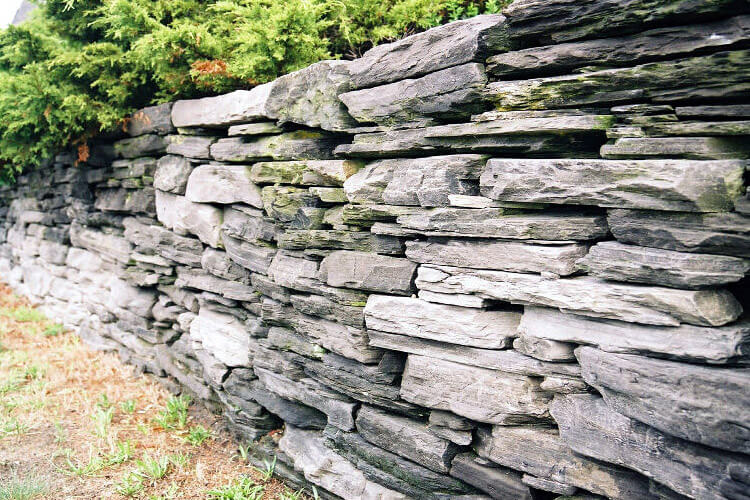
Crystalline ore is a name that summarizes several types of stones. The structure of this species is distinguished by dark-colored minerals, the color palette includes gray, white and light blue shades. The stone is widespread in Russia, Europe and the United States.
Mica-quartz schist, in comparison with other varieties, has a close relationship with quartz ores. Small cracks and hills can be observed on the surface of the mineral.The dominant shade of this breed is light green. Siliceous shale is similar in its characteristics to other groups, but impurities of other metals prevail in its composition. Flint gives the ore a unique color and shape.
Volcanic tuff
After volcanic eruptions, rock stones are formed on the basis of ash. Tuff is a porous, lightweight, cemented rock of volcanic origin. The stone is formed from the products of volcanic eruptions:
- sand;
- ash,
- lapilli;
- bombs.
There may also be rock fragments that are not related to volcanoes. Since tuffs are of volcanic origin, their composition varies. In their composition, they may have more than one layer of materials after several eruptions. Volcanic fragments also differ in density; they can be loose and dense. This makes it possible to use them for different purposes. Due to the eruption, the stone has remarkable lightness and excellent water and frost resistance.
 Depending on the sample, tuff can be very soft, which makes it easy to process it without the use of special tools. To do this, it is enough to have an ax or a saw. In terms of its strength, it is not worse than granite, and some other properties are even better than that of granite. There are quite solid formations that have lain under pressure and have already strongly stuck together.
Depending on the sample, tuff can be very soft, which makes it easy to process it without the use of special tools. To do this, it is enough to have an ax or a saw. In terms of its strength, it is not worse than granite, and some other properties are even better than that of granite. There are quite solid formations that have lain under pressure and have already strongly stuck together.
The name of the volcanic material is due to Southern Italy, since in that area it is most of all found. There are also rich tuff deposits in Armenia, Iceland and Cape Verde. They are found everywhere where there are active and extinct volcanoes.
Terrigenous-carbonate group
The group of terrigenous-carbonate rocks is a relatively heterogeneous community, including dolomite, limestone dominated by dolomite or calcite with an obligatory admixture of terrigenous components of various dimensions, as well as clayey, silty, sandy, gravel, pebble limestones and dolomites. Carbonate-terrigenous rocks with a carbonate content of less than 50% identified by some lithologists are not strictly carbonate rocks. These are clastic rocks cemented by carbonate material.
Like clastic fragments, the composition of carbonates often contains an admixture of clayey matter. A number of carbonate rocks, limestones and dolomites, including clayey material, are completed with marl with a clay component content of 25-50%.
Table 2 - Classification of terrigenous-carbonate rocks (according to I. V. Khvorova)
| Breed | Carbonate minerals,% | Terrigenous component,% |
| Limestone (dolomite) | 95-100 | 0-5 |
| Silty (sandy) limestone (dolomite) or limestone with gravel (with pebbles) | 75-95 | 5-25 |
| Silty (sandy, gravel, pebble) limestone (dolomite) | 50-75 | 25-50 |
| Calcareous (dolomite) silt (sandstone, gravel, conglomerate) | 25-50 | 50-75 |
During catagenesis, carbonate rocks can be leached, recrystallized with the appearance of such textural features as pond texture, stylolite seams, and secondary porosity. Secondary porosity is associated, according to E.F. Emlin, with the selective dissolution of carbonate rock components, with dolomitization (the formation of pores due to a decrease in volume), with the decomposition of organisms with an external skeleton (crinoids, corals, etc.).
The porosity of carbonate, carbonate-terrigenous accumulations, which underlies the formation of reservoirs, plays an important role in the geology of oil and gas.
The main settings of carbonate sedimentation are marine, in which shallow and deep-water carbonate muds accumulate, shelf, where foraminiferal, oolitic limestones, shell rocks, pellet sands, reef, bank-reef formations are formed.
Areas of application of mineral raw materials
The rock is not rare, deposits are being developed all over the world.Dolomite reserves in the territory of the Russian Federation are unevenly distributed, and the main deposits of raw materials are concentrated in the Central Federal District, the Urals and Siberia.
Depending on the shape of the rock and the depth of development, limestone is mined from using special equipment, different in functionality.
The material is used in various industries, metallurgy. Limestone in construction is used as:
- untreated blocks of stone;
- rubble;
- lime (white);
- facing slabs;
- mineral chips and sand;
- wall stone;
- mineral wool and powder;
- flour.
The cement industry uses varieties of mineral raw materials - chalk and marl. The use of the material in construction as a component for mortars, concrete, plaster increases the quality and reliability of work.
The special properties of carbonate formations make them an attractive material for decorative and finishing work. A variety of texture and texture characteristics serve as a decoration for any interior.
Carbonate material (alabaster, gypsum) is an ornamental stone. During its centuries-old history, it has been used to make figurines, candlesticks, and jewelry. Products that have come down to our times are in demand among collectors and art connoisseurs.
Flux limestone and dolomite are used in metallurgy as a material and raw material for processing nepheline ores into cement, soda and alumina. Lime stone is used as a material for the construction of hydraulic structures.
The fluxing additive of the component, introduced into the blast furnace charge in order to lower the melting point of the rock that does not contain the ore component, is the only type of the main additive. In metallurgy, dolomitized limestone is used, which increases the content of magnesium oxide in the slag, which increases the mobility and stability of the chemical and physical properties of the material when the temperature gradient changes.
The production of the used compound, which changed the requirements for the properties of the flux, made it possible to work with fragile materials. Therefore, shell rock is used as a charge. Its structure (high porosity) improves the technological process and quality of the material, and the chemical composition has a positive effect on maintaining temperature conditions.
The use of limestone in agricultural production (dolomite flour) reduces soil acidity and increases crop yields. The rock is used as a raw material in the glass industry.
The limestone component is used for cleaning sugar from impurities, polishing non-ferrous metal products, outer coating of electrodes and thermal insulation of structural joints.
Physical properties and deposits of stone
Slate is a popular type of rock that is highly durable and resistant to sudden changes in temperature. The stone is waterproof and fireproof. Under the influence of the environment, it is able to turn into a crystalline shale, which is easily split into plates.
Observations of minerals began in the 19th century in Buryatia. Studying the characteristics of minerals, Prince Kropotkin noted a wide variety of shale ores. In the Tunkinskaya depression, where there used to be a deep lake, eroded rocks were found. This fact made it possible to establish the influence of environmental conditions on the formation of valuable minerals.
One of the leaders in the extraction of shale ores is the United States. Countries such as Russia, China and Poland are not lagging behind. Since 2012, the term “shale revolution” has been introduced. This designation indicates the active introduction of shale rocks into the industry and the efficient use of natural gas. Slate cookware is famous for its beauty and affordable price.

Slate is waterproof and fireproof
